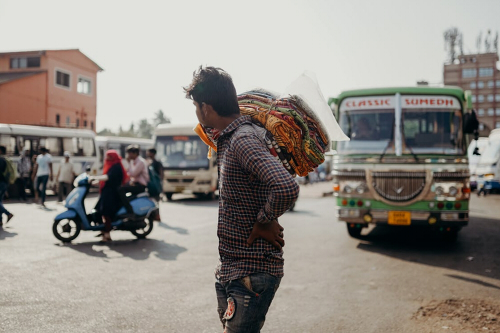India Coronavirus: Young Bearing the Brunt of Sweeping Job Losses
Soutik Biswas
In early May, Shalika Madan, who worked in a law firm in the Indian capital, Delhi, received a call from her office and was told that she was being laid off.
Ms Madan, a 38-year-old single mother of a son with special needs, had spent more than two years with the firm. A grinding lockdown to prevent the spread of coronavirus had shut down life and business in the capital.
“I begged and begged them to retain me even without a salary. My boss said he had run out of business and money. He knew my situation, and said he was helpless,” Ms Madan, who has more than a decade of work experience in office administration, told me.
She joined millions of Indians whose jobs have disappeared because of the pandemic. A month after the lockdown, 121 million Indians were out of work, according to the Centre for Monitoring Indian Economy (CMIE), an independent think tank.
Since then, the Indian economy has clawed back tens of millions of jobs, mainly in the informal and rural economies. (The bulk of India’s 400-odd million jobs are in the informal economy.)
The CMIE, which conducts one of the world’s largest continuous surveys to track household incomes, expenses and assets, reckons that 70 million such jobs lost at the peak of the lockdown in April have returned.
This is mainly because of the resumption of some economic activity and a bumper harvest that has not only helped absorb a large workforce but also created extra jobs on farms. The nationwide rural jobs guarantee programme has also helped.
That’s where the good news appears to end.
Some 19 million salaried, formal economy jobs have been lost after the lockdown, estimates the CMIE. A separate report by the International Labour Organisation (ILO) and the Asian Development Bank (ADB) estimates that more than 4 million Indians below the age of 30 have lost their jobs due to the pandemic. Those aged 15-24 are the hardest hit.

“The hit is largely among young people who are below 30 years. Companies are retaining experienced people and the axe is falling on younger people,” Mahesh Vyas, managing director of the CMIE, told me.
This, many believe, could be the most worrying aspect of the joblessness blighting India’s slowing economy, which is likely to contract sharply this year.
“Trainees and probationers have lost their jobs. Companies are not hiring on campuses. There’s a hiring freeze. When the next batch of job seekers graduate in 2021, they will join the army of unemployed,” says Mr Vyas.
Postponement of jobs for fresh graduates means depressed wages, erosion of return on education, and lower savings in the long run. “It impacts the job seeker, their families, the economy, everything,” Mr Vyas adds.
Household incomes are also shrinking because of widespread salary cuts and sluggish demand, forcing firms to cut corners. CMIE surveys in previous years would usually find some 35% of respondents saying their incomes were better than the previous year. This year only 2% of the respondents feel that way.
The decline in wages cuts across all groups – from the poor to the upper middle class. Salaried Indians have already withdrawn $4bn (£3bn) from a mandatory contribution fund in four months after the lockdown, presumably to meet expenses after job losses and salary cuts, according to a report. “The shrinkage of incomes is particularly striking in the middle and upper middle class,” says Mr Vyas.
Also, more people are dropping out of the workforce because there are no jobs available. This is not a new development: a 2017 study by economist Vinoj Abraham, using jobs data collected by the labour bureau, found an absolute decline in employment – a drying up of existing jobs – between 2013-14 and 2015-16, possibly for the first time in independent India.
Labour participation in the workforce – a measure of an economy’s active workforce – has fallen to around 35% from around 46% before the controversial 2016 currency ban that crippled India’s economy, according to CMIE estimates. The current unemployment rate of 8% hides this shrinkage. “This happens when it’s futile to look for a job because none is available,” Mr Vyas says.
Ms Madan would agree. She sent out her resume to two dozen firms without success even as she dipped into her savings and her mother’s pension. “I have stopped looking for jobs now,” she told me.
Income insecurity is acute in India. A study by researchers Marianne Bertrand, Kaushik Krishnan and Heather Schofield on how Indians were coping during the lockdown found that only 66% of the households had the resources to go on for more than another week before facing economic distress.
Finance Minister Nirmala Sitharaman has said the government is not in denial over job losses. Even new employment in government fell by 60% in June compared to the monthly average in the last financial year.
Last week, Ms Sitharaman told a meeting that India was “facing an extraordinary situation… an act of God where we may even see a contraction”. The Covid-19 caseload is inching towards 3.5 million, and much of the economy remains stalled. A full economic recovery seems to be distant.
The informal economy is slowly picking up, as many workers who returned to their villages after losing jobs after the lockdown are slowly trickling back to cities as their workplaces open up. Some are even getting paid more by their employers desperate to reopen their businesses.
“By the end of the year, more jobs will return as the economy continues to open,” says KR Shyam Sundar, a labour economist. “But salaried employment will take time to pick up. This is going to be a long haul.”








